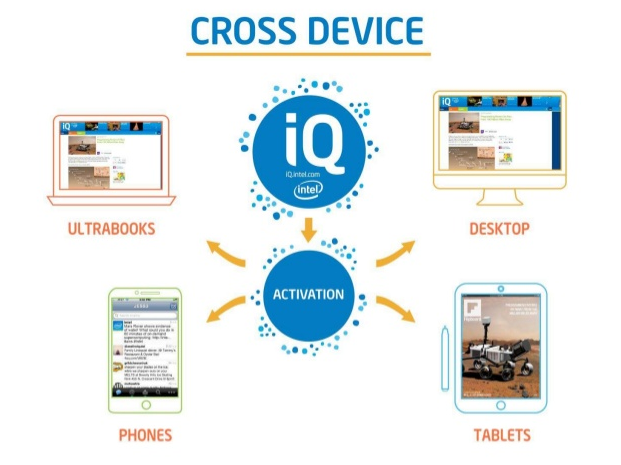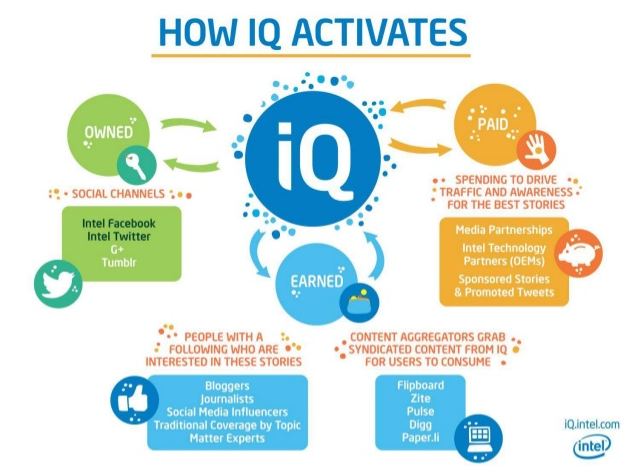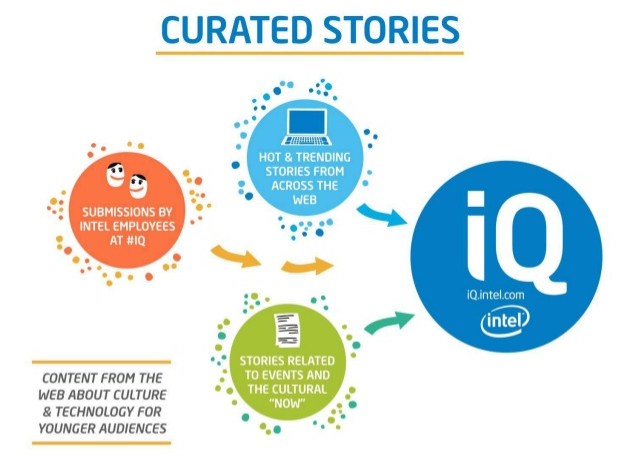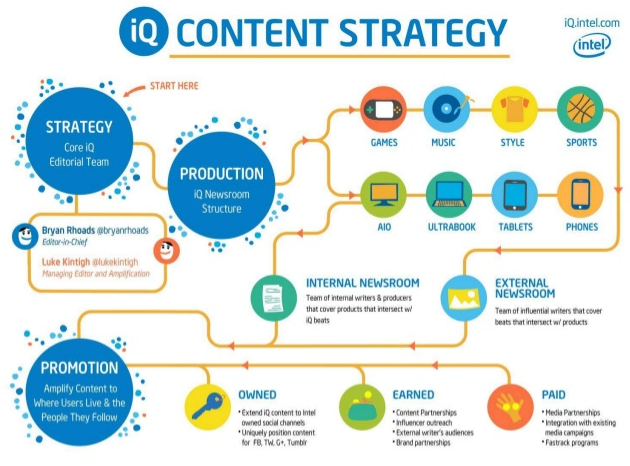When I started my career in digital marketing in 2009, “content” and “marketing” were not seen as synonymous words or practices. Sure, they had reasons to get along and like each other, but their Facebook relationship status would have likely been “it’s complicated.”
Fast forward to today and the status of content and marketing has escalated to read “in a relationship” in our news feeds. It seems the popular couple is everywhere with massive conferences and cover stories devoted to its lure and attraction. Just ask any marketer how times they’ve heard “content is king” in the last 6 months whether content marketing is the latest buzzword de jour.
There is no doubt content marketing is shaking up the marketing world, forcing CMOs to re-think and shift their resources to create newsrooms, content labs and postions such as Chief Content Officer and Content Strategist.
Intel Steps Into the Publishing World: iQ is Born
When I joined the corporate marketing group at Intel in the fall of 2011, content marketing was well under way. At the heart of this effort was a new media property called iQ by Intel that was chartered to grow Intel’s footprint as a brand publisher. I was appointed the Managing Editor, working alongside Bryan Rhoads, iQ Editor-in-Chief, an early visionary and content marketing leader at Intel. After months of development and strategy sessions, iQ BETA was launched in May of 2012. The primary objectives for the new site included:
- Create A Cross Device Storytelling Experience: iQ set out to highlight and narrate our modern world and the personal impacts of the technological ecosystem on our modern planet. Overt marketing “fluff” with little regard for audience demand was to be left at the door for content that one would actually want to share and consume—all while being designed and delivered to create the same level of experience and engagement whether you’re viewing iQ on a laptop, tablet or smart phone.

- Take the Pulse of the Web: Curation was crucial element to iQ to capture what’s trending in real-time on the web. We developed a unique algorithm to curate trending technology stories from sources that younger audiences read and shared by our known influencers. Read more about how iQ curation works from Content Curation Marketing.
- Leverage Our Collective Intelligence: With over 30,000 Ph.D’s, Intel has an extremely deep bench of expertise in nearly all facets of technology. Crowd-sourcing their collective intelligence was essential to provide a unique perspective for the iQ curation layer. Using a simple integration with Twitter, selected employees can use #iQ in their tweets and automatically help curate iQ and the content that is surfaced on the site.
- Think & Act Like A Publisher: Consumer’s attention span is becoming shorter by day with more choices at their fingertips to engage with awesome and compelling content. This reality is raising the stakes for Intel to think and act like publishers in order to win our audience’s attention, and ultimately their business. We strongly believed that iQ was the publishing vehicle that could deliver cohesive and immersive content to create the “brand as publisher” mindset.
- Feed the Social Graph: The content on iQ was developed for a post destination world, and optimized for the social graph and sharing. iQ content was also aimed to provide Intel’s social channels with steady supply of engaging content to share with our communities on Twitter, Facebook, Google +, Tumblr and YouTube.
- Build a Robust Newsroom and Content Strategy: Over time, develop and grow a talented editorial team and newsroom infrastructure. Using a tested content strategy, fully integrate marketing campaigns, program and product priorities with the editorial team to produce and amplify iQ content to new and the built audiences of our social communities.
- Build a Media Property to Integrate Paid, Owned and Earned Media: Create a content engine that effectively integrates with our earned, paid and owned media activities. Ranging from a tweet from @Intel to getting picked up in Flipboard and using paid media dollars to boost awareness of a selected post, iQ content has the flexibility and potential to fully integrate into all aspects of the media and marketing strategy.

Drinking From the Content Marketing Fire Hose
As we launched the site, the iQ team started to work with a team of journalists and editorial partners, conducted editorial meetings and worked closely with the Intel social media team to amplify and extend iQ content. Before we knew it, we were beginning to operate a newsroom, managing a robust content machine and starting to see our goals for iQ come to fruition. By end of 2013, iQ was emerging as an essential asset to Intel’s marketing and social media strategy. Although satisfied with the early success of iQ, we knew there were many improvements to be made. In January 2013, iQ version 1 (the current site) was released. Several new changes and strategies were implemented from our learnings since the BETA launch. So what have I learned about content marketing in the last 11 months? I’ve distilled the 12 core lessons for brand publishers organized by the tenets of the iQ content marketing approach; production, process and promotion.
Production: Building Your Newsroom & Editorial Strategy
- Establish and Evangelize An Editorial Strategy and Identity: How do you ensure consistency and cohesion for your content with a wide range of contributors and editorial partners? We found the answer largely lied in a clear editorial identity and strategy for iQ that we distributed to iQ contributors and stakeholders. The editorial ID covers the desired tone, style, and voice as well target audience data and how to optimize the content for amplification using paid, owned and earned media. Worksheets and examples are also used to create an interactive and hands on approach for our writers as they create and develop content. The ID has turned into the Bible for iQ and something we can always go back to for foundations of our editorial strategy.
- Don’t Mistake Marketing Objectives for Audience Interests: I would receive the 5 key objectives for our latest campaign to include in my next blog post and I would ask myself, “will our target audience really respond to this at face value ” This is where I learned to take off my maketing hat and put on my journalist hat. As a journalist would do, begin with audience demand and what keeps the reader up night and gets them out of bed. How can I help identify a gap in their needs and provide true value? Once I figured this out, then I could back into the maketing objectives. Articulate the “why” then proceed with the “what.” Doing this backwards will often times result in a message that’s forced and smells of overt marketing.
- Pay for Performance, Not Just Content: I’m a big advocate of hiring journalists. We’ve found there are great resources out there to discover talented and affordable freelancers, but many of these services don’t incentivize or compensate writers to generate traffic for your content. Look to see if you can negotiate or find methods to pay your writers, at least partially for performance and not 500 words of text. Using a “pay for performance” methodology is already being used by Forbes and other publishers. This model ensures a better R.O.I on your freelancer budget and will force you to work with writers who have built in audiences, which they’ll be rewarded to distribute your content to on a regular basis.
- Learn to be Creatively Rapid: In today’s digital economy, timing is everything. As AdAge wrote, “Consumers’ attention spans are shortening by the second; most news is only relevant for a day or two, if not less… We’ve seen time and time again that culturally relevant content achieves engagement.” To capitialize on real-time marketing your team has to move quickly all while creating compelling content. Set up a workflow for how to quickly respond to opportunities, practice proactive scenario planning and most importantly don’t be afraid to take risks at moment’s notice. It can pay off as we recently experienced with the Intel Harlem Shake reaching 119,000 organic views.
Process: Keeping the Trains Running on Time & the Passengers Happy
- Consolidate Metrics and KPIs: As content marketing becomes more integral in the overall marketing mix, the more important the systems will be to track and measure the impact of content on sales and performance. It is difficult to use data when it is living all over the place creating inconsistencies and fragmented results. That is why integrating your metrics and data sources is a great first step to help better guide your marketing efforts using data. Think about how you can consolidate your data and continually research potential marketing automation software and tools that can tie sales indicators to your content KPIs.
- Don’t Underestimate the Power and Efficiency of Great Tools: Relying on email and spreadsheets to manage your content may seem adequate. However, you’ll soon find generic tools don’t scale well and cost more time and money in the long run. Effective content management tools can not only create a robust content management hub, but will also enable contributors and stakeholders to collaborate more effectively through customized workflow. We’ve found a solution that’s acts as our CMS, editorial calendar, file storage system and content submission workflow, all in one. Although it takes time to get tools up and running, the investment will pay off in many ways.
- Identify Storytellers and Great Writers in Your Organization: Intel is a company of 100,000 employees, so it is no surprise there are some talented storytellers. However, we’ve learned being a great writer is no easy task or skill. Look outside the usual suspects of PR and communications for talent. You may find some potential contributors who can bring a unique skill set to your content outside of the typical blog post in the form of visual content, creative design or story ideas. Plus, often times these people are closer to customer, so they understand your audiences more intimately. Some of best internal iQ stakeholders are not in corporate marketing.
- Taking Your Editorial Calendar a Step Further: Adding some key elements to your editorial calendar can greatly optimize your content strategy and day-to-day operations. Here are some items and meta data we’ve added to our calendar and content management system:
- Target Audience: What persona and/or sub-set of an audience is your content targeted?
- Buying Stage: Where in the sales funnel or buying process is the content intended to serve?
- Cross Promotion: After the content is published, where else can it be extended (social media and digital channels)?
- Weekly & Monthly Themes: What’s the big story (event or product campaign) driving your content each week and month?
- Content Tagging & Mapping: How can you tag your content so it’s mapped to business objectives and content goals?
- Call-to-Action: What are you ultimately asking the reader to do and how is it tied to business objectives?
Promotion: Clicking Publish is Only Half the Battle!
- Less Can Be More: At the beginning of iQ, we had the mindset that the more content we cranked out, the better. You could call this the “field of dreams” approach–”if you publish it, people will come.” This philosophy totally disregards the importance of distribution and promotion and we quickly found out is extremely flawed. Without a strategic approach to amplification, your content won’t go far. You need to spend just as much time with promotion as production, in fact probably more. This resulted in reducing production and increasing promotion. Today, we spend at least 50% of our time proactively working all promotion angles. Although we produce less content than we once did, our traffic and engagement has more than doubled. So in our case, yes, less is more!
- Think Natively When You Distribute Your Content Socially: With so many social channels available to the consumer, distributing content has turned into a very complex process. You many think the “cookie cutter” approach of using the same copy and imagery across all social media channels will ensure your story is told in a consistent way. However, this strategy neglects the inherent audience behavior for each social media community. What works on Twitter, doesn’t necessarily work on Facebook and vice versa. It comes down to knowing the native behavior of the audiences of your social communities. This means creating animated gifs on Tumblr, using hash tags on Twitter, and strong visuals on Facebook—all attributes unique to way users respond to content on the platform.
- Don’t Just Syndicate—Co-Create: While there are a plethora of effective paid media vehicles to syndicate content, co-creating content with publishers can be a more authentic and successful option. iQ has an ongoing editorial partnership with PSFK, where we co-create content, which is published to our respective sites and social channels. iQ and BuzzFeed have a similar partnership. In apsfk.comddition to being promoted on BuzzFeed and iQ, this recent co-created post was also used for several tweets and Tumblr posts using selected images from the article. By co-creating content with like-minded publishers, you can strategically leverage their talent, and more importantly access to their audience. Simply renting 4 square inches on a publisher’s homepage won’t necessarily accomplish the same result.
- Bring Influencers Into Your Content Early: Tapping topic influencers for quotes and insights will not only provide great sources for your content, it will also increase the chances of your content getting shared by them. Utilize tools and methods to identify the top influencers for the subject matter of your content. Consider an influencer’s social footprint when deciding who to source for your article. Could they give your content a boost if they shared it? What level of influence do they have with other topic experts? What have they covered and how can you leverage it in your content? These are questions that will help identify and build relationships with influencers. After a successful interview, follow up with the influencer with a link to the story and encourage them to share it. Also, call out your source in tweets and other social posts for recognition and affiliation with them.




